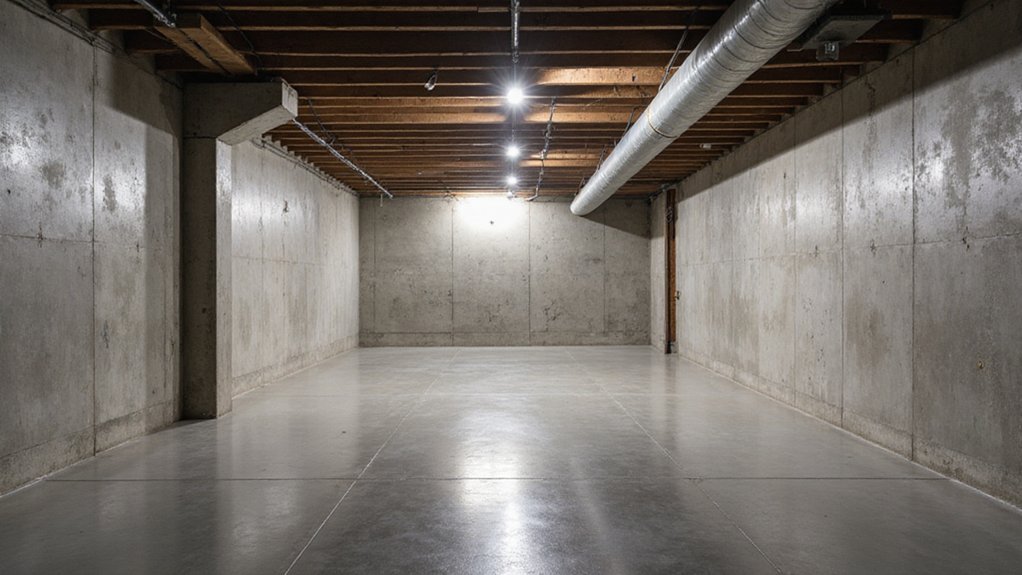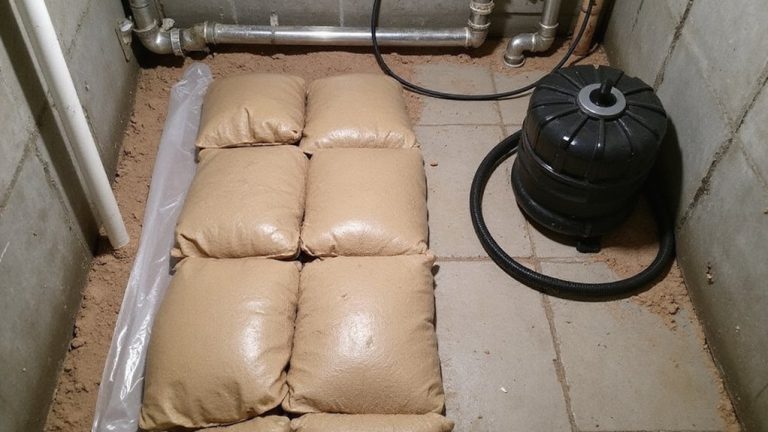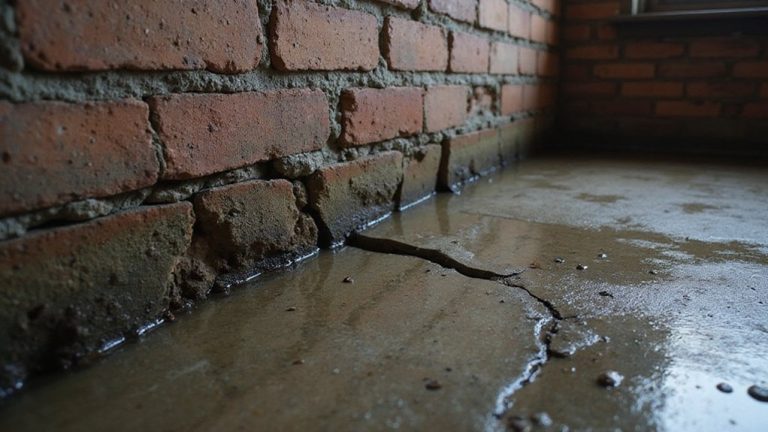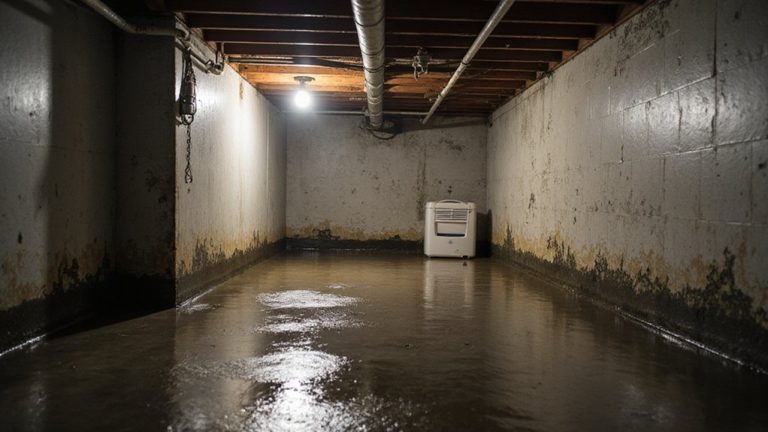Safeguarding your basement from water damage is vital for maintaining the structural soundness and livability of your home. While exterior waterproofing techniques shield the foundation, you’ll also need to ponder interior solutions like sump pumps and dehumidification systems to actively manage moisture intrusion. By adopting a thorough approach, you can guarantee long-lasting protection and avert expensive repairs in the future. But there’s more to investigate when it comes to the optimal waterproofing strategies for your basement.
Exterior Waterproofing
If your basement is prone to water intrusion, exterior waterproofing may be the solution you need. This method involves applying a waterproof coating or membrane to the outside of your basement walls. It can effectively prevent groundwater from seeping in and causing damage. Basement water damage can lead to structural issues and decreased home value, making professional intervention crucial. Consider installing a french drain system around the perimeter of your home to redirect water away from the foundation. Implementing erosion control measures, such as grading the terrain, can also help mitigate water issues. With professional installation and proper maintenance, exterior waterproofing can provide long-lasting protection for your basement.
Interior Waterproofing
While exterior waterproofing can be highly effective, some homeowners opt for interior waterproofing as an alternative solution.
This approach involves applying a protective floor coating or installing water-resistant wall panels to the basement’s interior. The floor coating creates a seamless, impermeable barrier, preventing moisture from seeping up through the concrete.
Wall panels, on the other hand, can be easily installed and provide an attractive, insulated finish while blocking water intrusion. Interior waterproofing is often more accessible and cost-effective, making it a popular choice for those looking to keep their basement dry and protected.
Sump pump installations can further enhance the effectiveness of interior waterproofing methods by actively managing water accumulation and preventing potential flooding.
Sump Pump Installation
A sump pump is an indispensable component for protecting your basement from water intrusion. It’s designed to remove excess water that accumulates in the pit, preventing it from seeping into your living space.
Consider backup system options like a battery-powered or water-powered sump pump to guarantee continuous operation during power outages. Regular maintenance is pivotal – check the pump’s operation, clear the inlet screen, and confirm the discharge line is unobstructed.
With proper installation and upkeep, a sump pump can effectively safeguard your basement and provide peace of mind. Don’t overlook this essential waterproofing measure.
Drainage System Improvements
Improving your home’s drainage system can be an effective way to combat water infiltration in your basement. Consider installing a French drain system to channel water away from your foundation. This involves burying a perforated pipe surrounded by gravel along the exterior of your basement walls.
Downspout extensions can also make a difference, directing rainwater several feet away from your home. These simple upgrades help prevent pooling and reduce the risk of leaks. With a proper drainage system in place, you can keep your basement dry and protect your investment.
Basement Dehumidification
Excessive moisture in your basement can lead to a host of issues, from musty odors to mold growth. Implementing a reliable basement dehumidification system is essential for moisture control and humidity reduction.
These systems work by extracting excess moisture from the air, helping to maintain ideal humidity levels and prevent the buildup of damaging condensation. By regulating the humidity, you can safeguard your home’s air quality and protect your belongings from the risks associated with high moisture.
Investing in a well-designed dehumidification solution can provide long-term peace of mind and preserve the integrity of your basement space.
Crack Sealing and Concrete Repair
Dealing with cracks and concrete issues in your basement is essential for maintaining a dry, secure living space. Proper concrete surface preparation is key – you’ll need to thoroughly clean and repair any damaged areas before applying caulk and sealant.
Be sure to use high-quality, flexible products designed for basement environments. Apply them carefully, sealing any cracks or gaps to prevent water intrusion. With the right preparation and sealants, you can effectively address concrete problems and waterproof your basement, creating a safer, more comfortable space for your family.
Vapor Barrier and Insulation
Once you’ve addressed any concrete issues, you’ll want to turn your attention to installing a proper vapor barrier and insulation in your basement. A vapor barrier, typically made of polyethylene or a similar material, creates a critical seal that prevents moisture from seeping through.
By choosing the right insulation, like fiberglass or rigid foam panels, you can also bolster your basement’s temperature regulation and energy efficiency. These simple yet effective measures work together to protect your space from dampness and keep it comfortable year-round.
Don’t overlook this essential step in your basement waterproofing project.
Window Well Covers and Drainage
Window wells are essential components that protect your basement windows, but they can also be a prime entry point for water intrusion. Proper window well maintenance and landscaping are key to preventing leaks.
Install well-fitted covers to keep out rain, snow, and debris. Guarantee the well’s drainage system is clear and functioning to swiftly channel water away from your home’s foundation. Landscaping around the window well with gravel or sloping the soil to direct water away can further enhance its effectiveness. Taking these simple steps will safeguard your basement and give you peace of mind.
Frequently Asked Questions
How Do I Prevent Mold Growth in My Basement?
To prevent mold growth, guarantee proper ventilation and install a moisture barrier in your basement. This will regulate humidity and block water penetration, creating a dry, mold-resistant environment you can feel comfortable in.
Can I Waterproof My Basement Myself?
Yes, you can waterproof your basement yourself using DIY waterproofing techniques. But if you want a long-lasting, professional job, consider hiring waterproofing services. They have the capabilities to verify your basement stays dry.
How Often Should I Inspect My Basement for Leaks?
Perform seasonal inspections of your basement to check for leaks. Consider scheduling professional evaluations periodically to safeguard your home’s waterproofing remains effective and your family’s safety is secured.
What Are the Signs of a Faulty Sump Pump?
Frequent maintenance checks are essential to spot faulty sump pumps. Unusual pump noises like grinding or squeaking may indicate issues. Don’t wait – address problems without delay to prevent basement flooding and safeguard your home.
Can I Use a Dehumidifier Instead of Waterproofing?
You can install a dehumidifier as an advantage to address moisture issues, but it won’t prevent water intrusion the way waterproofing can. Dehumidifiers are a temporary fix, while waterproofing provides long-term protection.



